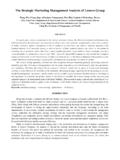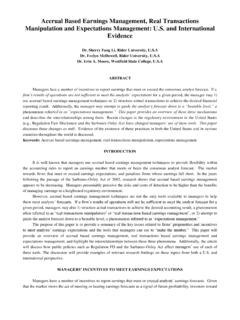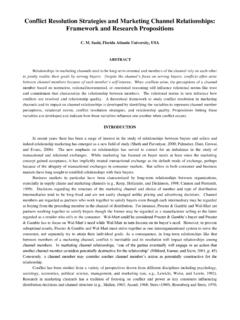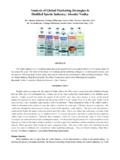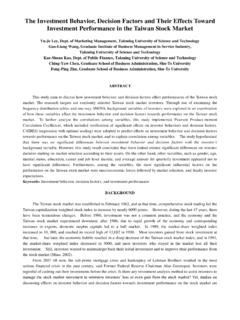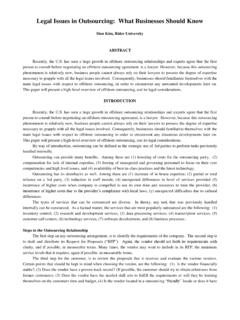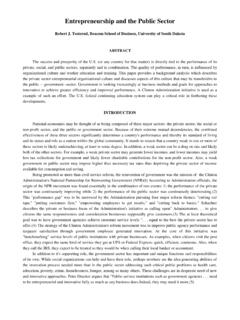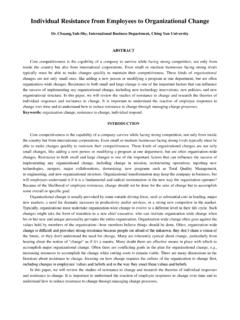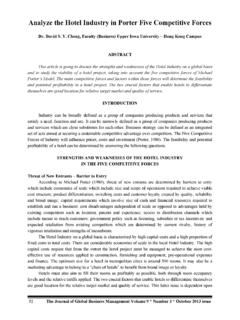Transcription of Expansion Trend of Fast Food Franchises in Metro Manila
1 Expansion Trend of Fast Food Franchises in Metro Manila Chen, Mei-Liang, Lecturer, Department of International Business, Hsin Sheng College of Medical Care and Management, Taiwan Chen, Kuang-Jung, Professor, Department of Business Administration, Chihlee Institute of Technology, Taiwan Liu, Chu-Mei, Department of International Trade, Tamkang University, Taiwan ABSTRACT This study of late 2009 analyzes fast food buying behavior in Metro Manila and compares and contrasts the marketing s four P s of twelve fast food Franchises . Fast food Franchises dominate the food and beverage industry, and there are currently thirty-two thousand fast food restaurants in Metro Manila . The most commonly used promotion tools of these restaurants are window dressing, free delivery, and radio, TV, and flyer advertisings. The success of Manila s fast food industry lies in its standard processes, limited menus, enhancement of values, speed, swift services, and distribution right.
2 Fast food industry has successfully changed most people s daily habits in many big cities. Nevertheless, fast food Franchises are reluctant to develop in suburban areas. Regarding this, there is still plenty of room for fast food industry to expand in the Philippines. Keywords: Fast Food Industry; Influence Behavior; Markets; Marketing Strategies Filipinos are increasing into fast food, as the rapid Expansion of fast food restaurants in Metro Manila can prove that. There are currently many newly opened fast food restaurants across Metro Manila and other major cities in the Philippines. Growth of population and changes in consumer behavior has facilitated the prosperity of fast food industry. In addition, influxes of population and changes in lifestyles such as preferences for leisure, convenience, and food-away-from-home, women s changing role in the society, and the urbanization of families all contribute to the growth of fast food industry.
3 Fast food industry builds upon two basic individual demands. From its model of franchise and product concepts, fast food industry will continue to grow. Being exposed to media advertisement, consumers dining habits have been changed. Furthermore, given the reasonable and affordable product prices, the increasing number of white-collar workers particularly white-collar women, whether single or married, young or old has boosted the demand for food service. Therefore, fast food industry can be said to develop upon the structural changes in working class and families. Statistics indicates that there are currently thirty-two thousand fast food restaurants in Metro Manila . However, the survey of consumer tendency in Metro Manila shows that profits of fast food Franchises depend on product consumption frequencies.
4 Most fast food Franchises create profits by expanding branch stores. Obviously, there is still plenty of room for fast food industry to expand. Therefore, it is necessary for managements to apply effective management strategies for promotion programs. However, many enterprises are indifferent to whether or not advertisings or promotion strategies will facilitate their sales performances, despite the fact that integrating product, price, place, and promotion strategies into marketing mixes is a key process during decision-making. Given that fast food Franchises dominate the food and beverage industry, this study aims to analyze fast food buying behavior in Metro Manila and compare and contrast the marketing s four P s of twelve fast food Franchises . The twelve fast food Franchises here refer to MOS Burger, Tropical Hut, Shake, Pizza Hut, Jollibee, Domino, McDonald s , Wendy s, KFC, Cindy s, Burger King, and Subway.
5 THEORETICAL FRAMEWORK This study carries out a thorough research on consumer behavior based on the theories of Hawkin et al. (1983) in an attempt to propose effective marketing strategies and feasible guidelines for these strategies. Hawkin et al. defined consumer lifestyle as a way of reflecting individuals self-images and self-concepts. It is also an accumulation of previous experiences and future plans. Therefore, each individual or family has his/her own unique lifestyle. Products can indeed maintain or change individual or family lifestyles. It is suggested that products should be evaluated based on their relationship with consumer lifestyles. Therefore, managers should understand consumers lifestyles and factors affecting them. Many marketing managers usually survey consumers demographic traits, but related data is insufficient.
6 Instead, studying consumers lifestyles can help marketing managers to realize that consumers are individuals who have thinking and desires and that why consumers purchase certain products. In the case proposed here, the couple who decides to eat out has to consider whom they are dining with. If they are eating out with out-of-town relatives or special friends, they need to choose a restaurant with fine atmosphere or special features. If they are going with their children, they need to choose a restaurant suitable for families. Table 1 indicates selections of restaurants based on different situations, which refer to the time or location in which the consumers use a product or service. These situations cover all factors influencing the purchase and use of products but not just factors of marketing or service.
7 Table 1: Restaurant Selections based on Different Situations Situations Restaurant Selections Situations Restaurant Selections My wife and I are going to celebrate our 20th marriage anniversary, and our best friends are coming, too. A restaurant with fine atmosphere or features My father s birthday is in next week. He likes to try something new, so I am going to surprising him by taking him to an exotic restaurant. A restaurant serving exotic cuisines We are taking our kids to a restaurant. Hope they will behave. A restaurant for families I can only squeeze out 30 minutes from my client visits. I am in a rush. A fast food restaurant Under different situations, consumers select different forms of products in the same category. Given that different types of restaurants attract people in different situations, marketing managers can segment markets based on consumer expectations.
8 For instance, the beverage Gatro-Aid is designed to help people who have just finished exercising to quench thirst, such as people who have just played tennis. On the other hand, in a social occasion where beverages for diluting alcohol are required, 7up will do. Marketing guru Kolter (2008) stated that to succeed in selling a product requires an effective and complete marketing mix, which includes product or service selection, pricing, promotion tool selection, and identifying the connection with consumers. He further pointed out that to achieve their goals, marketing managers must understand the needs and demands of their target markets and create more satisfactions for their consumers than their competitors. Giving considerations to consumer satisfactions helps to make more feasible marketing plans.
9 Figure 1 indicates the twelve fast food Franchises marketing strategies of product, pricing, promotion, and place in an attempt to create stronger and more positive consumer attitudes and behavior. It is essential for products to meet target consumers demands. Given the ever-changing nature of the market environment, the process of matching products and demands should be dynamic. Therefore, this study explores how fast food Franchises apply marketing s four Ps to establish brand loyalty and increase market shares. Figure 1: How Consumer Buying Behavior Influence Marketing s Four Ps of Fast Food Franchises Related Literature and Research Enterprises make marketing strategies in an attempt to achieve sales goals and increase transactions. Typically, the purpose of marketing strategies is to increase profits or consumption frequencies, such as to make consumers frequently purchase certain products from certain stores.
10 Such a purpose can be fulfilled by applying marketing mixes to a selected target market. Understanding consumers is a key factor in the making of marketing strategies. As indicated in Table 2, strategy-making always involves in considerations of consumer behavior. For instance, a marketing manager must understand how consumers perceive and feel about a competing brand, who purchase the competing brand and why, and under what types of situations do consumers purchase and use products of the competing brands. These are all questions must be asked and answered when analyzing sellers and buyers. Generally speaking, the more you know your consumers, the more likely that you will work out a set of successful marketing strategies. Table 2: Question Samples Relevant to Marketing Strategies Strategic Elements Questions about Consumers Segmentation Who are our potential consumers for our product?
